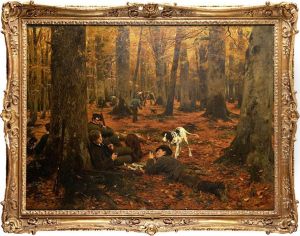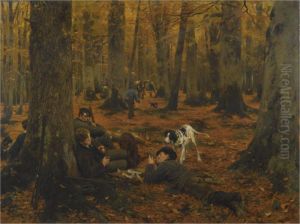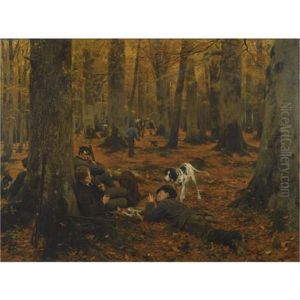Wilhelm Simmler Paintings
Wilhelm Simmler was a German artist born on December 2, 1840, in Frankfurt am Main, Germany. His artistic journey began at an early age, influenced by the rich cultural and artistic heritage of his hometown. Simmler is primarily known for his contributions to portrait painting, genre scenes, and historical subjects, which reflect a meticulous approach to detail and a profound understanding of human emotions and narratives. During his lifetime, Simmler's works were well-regarded for their realism and depth, capturing the essence of his subjects with remarkable sensitivity and skill.
Simmler's education in art was comprehensive and grounded in the classical traditions of European painting. He studied at the Städelsches Kunstinstitut in Frankfurt before continuing his education at the Academy of Fine Arts Munich, one of the most prestigious art schools in Germany at the time. This period of study honed his technical skills and deepened his appreciation for the historical and cultural contexts of art. Throughout his career, Simmler remained engaged with the artistic community, contributing to the development of the arts in Germany through his participation in exhibitions and cultural societies.
Despite facing the challenges of the changing art world of the late 19th and early 20th centuries, Simmler's work remained true to the principles of realism and detailed representation. His portraits, in particular, are noted for their psychological depth and the ability to convey the personality and inner life of the sitter. Beyond portraits, his genre scenes and historical paintings often depicted moments of everyday life and significant historical events with equal finesse, inviting viewers to engage with the narrative and emotional content of his works.
Wilhelm Simmler's contributions to German art were recognized during his lifetime, and he enjoyed the respect and admiration of his peers. His legacy is preserved in the collections of several German museums and galleries, where his works continue to be studied and appreciated for their artistic merit and historical significance. Simmler passed away on April 24, 1921, in Frankfurt am Main, leaving behind a body of work that continues to inspire and captivate audiences with its beauty and depth.





























